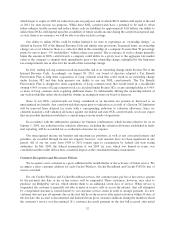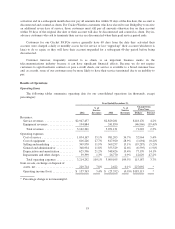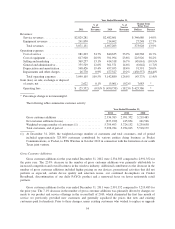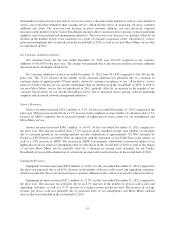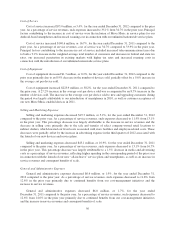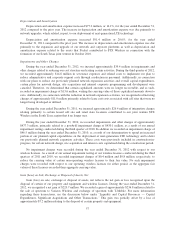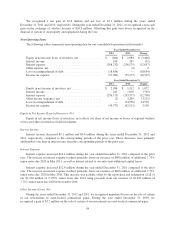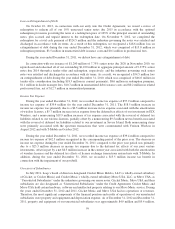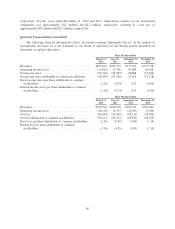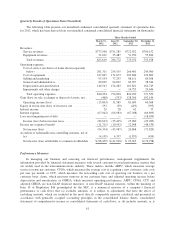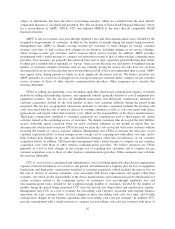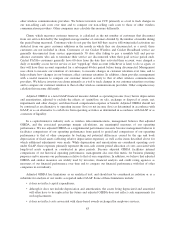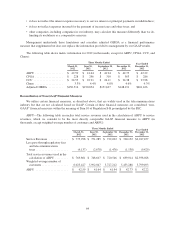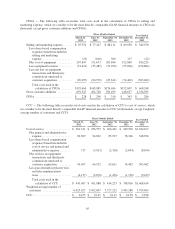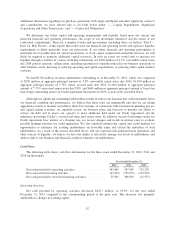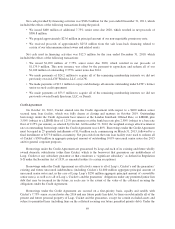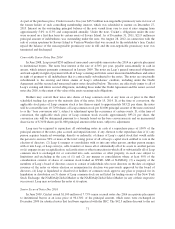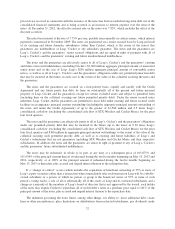Cricket Wireless 2012 Annual Report Download - page 76
Download and view the complete annual report
Please find page 76 of the 2012 Cricket Wireless annual report below. You can navigate through the pages in the report by either clicking on the pages listed below, or by using the keyword search tool below to find specific information within the annual report.subject to adjustments that have the effect of including amounts, which are excluded from the most directly
comparable measure so calculated and presented. See “Reconciliation of Non-GAAP Financial Measures” below
for a reconciliation of ARPU, CPGA, CCU and adjusted OIBDA to the most directly comparable GAAP
financial measures.
ARPU is service revenues, less pass-through regulatory fees and telecommunications taxes, divided by the
weighted-average number of customers, divided by the number of months during the period being measured.
Management uses ARPU to identify average revenue per customer, to track changes in average customer
revenues over time, to help evaluate how changes in our business, including changes in our service offerings,
affect average revenue per customer, and to forecast future service revenue. In addition, ARPU provides
management with a useful measure to compare our subscriber revenue to that of other wireless communications
providers. Our customers are generally disconnected from service after a specified period following their failure
to either pay a monthly bill or replenish, or “top-up,” their account. Because our calculation of weighted-average
number of customers includes customers who are not currently paying for service but who have not yet been
disconnected from service because they have not paid their last bill or have not replenished their account, ARPU
may appear lower during periods in which we have significant disconnect activity. We believe investors use
ARPU primarily as a tool to track changes in our average revenue per customer and to compare our per customer
service revenues to those of other wireless communications providers. Other companies may calculate this
measure differently.
CPGA is selling and marketing costs (excluding applicable share-based compensation expense or benefit
included in selling and marketing expense), and equipment subsidy (generally defined as cost of equipment less
equipment revenue), less the net loss on equipment transactions and third-party commissions unrelated to
customer acquisition, divided by the total number of gross new customer additions during the period being
measured. The net loss on equipment transactions unrelated to customer acquisition includes the revenues and
costs associated with the sale of wireless devices to existing customers as well as costs associated with device
replacements and repairs (other than warranty costs, which are the responsibility of the device manufacturers).
Third-party commissions unrelated to customer acquisition are commissions paid to third parties for certain
activities related to the continuing service of customers. We deduct customers who do not pay the first bill they
receive following initial activation from our gross customer additions in the month in which they are
disconnected, which tends to increase CPGA because we incur the costs associated with a new customer without
receiving the benefit of a gross customer addition. Management uses CPGA to measure the efficiency of our
customer acquisition efforts, to track changes in our average cost of acquiring new subscribers over time, and to
help evaluate how changes in our sales and distribution strategies affect the cost-efficiency of our customer
acquisition efforts. In addition, CPGA provides management with a useful measure to compare our per customer
acquisition costs with those of other wireless communications providers. We believe investors use CPGA
primarily as a tool to track changes in our average cost of acquiring new customers and to compare our per
customer acquisition costs to those of other wireless communications providers. Other companies may calculate
this measure differently.
CCU is cost of service and general and administrative costs (excluding applicable share-based compensation
expense or benefit included in cost of service and general and administrative expense) plus net loss on equipment
transactions and third-party commissions unrelated to customer acquisition (which includes the gain or loss on
the sale of devices to existing customers, costs associated with device replacements and repairs (other than
warranty costs which are the responsibility of the device manufacturers) and commissions paid to third parties for
certain activities related to the continuing service of customers), less pass-through regulatory fees and
telecommunications taxes, divided by the weighted-average number of customers, divided by the number of
months during the period being measured. CCU does not include any depreciation and amortization expense.
Management uses CCU as a tool to evaluate the non-selling cash expenses associated with ongoing business
operations on a per customer basis, to track changes in these non-selling cash costs over time, and to help
evaluate how changes in our business operations affect non-selling cash costs per customer. In addition, CCU
provides management with a useful measure to compare our non-selling cash costs per customer with those of
62


